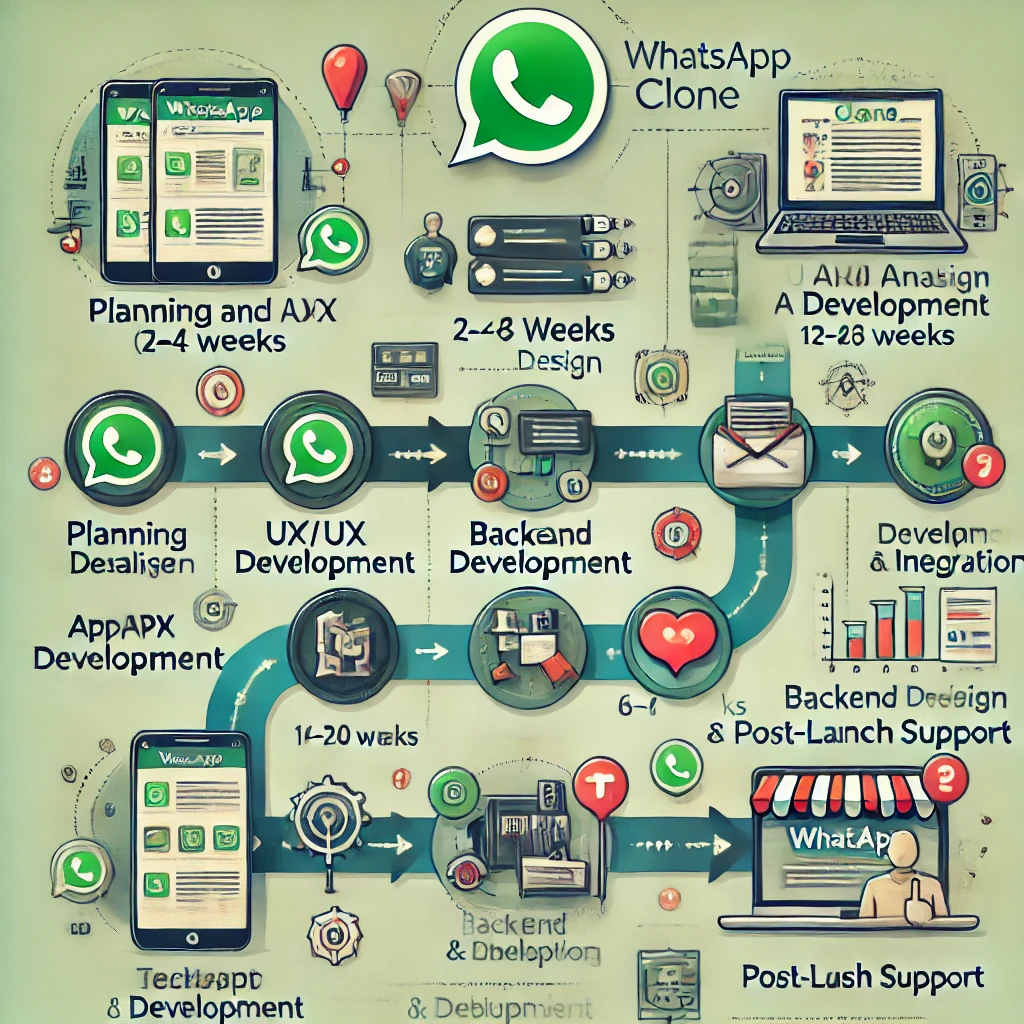How Long Does It Take to Develop a WhatsApp Clone Application for Business Use?

Strong 8k brings an ultra-HD IPTV experience to your living room and your pocket.
Developing a WhatsApp clone application for business use is an exciting venture that involves creating a messaging platform to facilitate communication within an organization or between businesses and customers. However, the development timeline can vary greatly depending on a range of factors, such as features, customization, platform, and developer expertise.
In this guide, we’ll walk you through the main stages involved in the development process and discuss the average time it takes to build a WhatsApp clone app for business purposes. Additionally, we’ll examine some key considerations and factors that influence the development time.
Key Factors That Affect Development Time
The time required to develop a WhatsApp clone app can vary depending on several factors. Let’s explore some key elements that can impact the overall development timeline:
1. Feature Set
The range of features you want to include in your app will play a crucial role in determining how long the development will take. A simple version of a WhatsApp clone with basic messaging functionalities like text, voice, and video calls will take less time to build. However, if you opt to add advanced features such as group management, file sharing, encrypted messages, voice notes, and custom themes, the development time will increase significantly.
Key features that could affect development time include:
User registration and login systems
Contact syncing
Real-time messaging
Voice and video calling
Push notifications
File sharing and media integration
Chat encryption
Admin panel for user management
Customization options (business branding)
2. Platform (iOS, Android, or Web)
Another important factor is the platform(s) you choose for your app. Building a WhatsApp clone for Android, iOS, or web requires different technologies and development processes, which can impact the timeline.
iOS App Development: iOS development typically requires Swift or Objective-C programming languages, which might take additional time for customization and testing.
Android App Development: Android apps are usually built using Java or Kotlin, and the development cycle may be slightly longer due to the larger range of device compatibility.
Web App Development: Building a web version of a WhatsApp clone requires additional considerations for cross-browser compatibility and responsive design, which may extend the timeline.
If you plan to release the app on multiple platforms (iOS, Android, Web), it will naturally take longer to complete the development process.
3. Customization and Design
A clone app's design is essential for its success. Creating a user-friendly and attractive interface with features customized to your business needs can take a considerable amount of time. Customization can involve changing the layout, adding logos, modifying UI elements, and incorporating new branding colors, among others.
Business Use Customization: Depending on the industry, you might need specific custom features like:
Integration with CRM systems
Multi-language support
Advanced analytics
Payment gateway integration for in-app purchases or business transactions
The more customized the app is, the longer it will take to develop. Be sure to work closely with your design team to finalize the look and feel of the app to streamline the process.
4. Backend Development
The backend of your WhatsApp clone app is responsible for managing data storage, message delivery, user profiles, security, and more. Backend development will require expertise in server-side technologies such as Node.js, Ruby on Rails, or Python, as well as integrating APIs for real-time messaging services.
For a scalable and reliable messaging platform, you will need a robust backend infrastructure to handle high traffic volumes, user management, and secure data transactions. The complexity of this infrastructure can significantly influence the development time.
5. Testing and Quality Assurance
No matter how fast the development process moves forward, it’s essential to allocate adequate time for testing and quality assurance. Rigorous testing ensures that all features work as expected and that any bugs or issues are identified and fixed before launching the app. This includes:
Functional testing
Usability testing
Performance testing
Security testing
Compatibility testing
For apps like a WhatsApp clone, testing becomes crucial due to the need for real-time communication features like voice and video calls. Ensuring that these functions work seamlessly across different devices and networks can add several weeks to the timeline.
Estimated Time for WhatsApp Clone App Development
Given all these factors, the estimated time to develop a WhatsApp clone app for business purposes can range from 3 to 9 months. Below is a general breakdown of the development process:
1. Planning and Analysis (2-4 weeks)
The first phase of app development involves defining the app’s purpose, features, and functionalities. This stage also includes designing wireframes and finalizing technical requirements. The time needed here depends on how clear your vision is and how much customization is required for your business needs.
2. UI/UX Design (4-6 weeks)
The design phase involves creating the visual interface for the app. Designers will develop the user experience (UX) and user interface (UI), which should be intuitive and visually appealing. This phase may take longer if custom designs are required for branding or if additional platforms need to be supported.
3. App Development (12-20 weeks)
This is the core phase of app development where most of the coding happens. The complexity of the app features will impact the duration of this phase. A basic WhatsApp clone app with core messaging functions can be developed within 3-4 months, whereas a more sophisticated app with added features will take longer.
4. Backend Development and API Integration (6-12 weeks)
Backend development involves setting up servers, databases, and APIs that will handle real-time data exchange. This is a critical part of building a functional app, especially for a messaging app like WhatsApp, where data security and message delivery speed are essential.
5. Testing and Debugging (4-6 weeks)
After development, extensive testing will be carried out to ensure that everything works smoothly. This phase may take longer if there are major bugs or performance issues that need fixing.
6. Launch and Post-Launch Support (2-4 weeks)
Once the app is ready, it will be launched on various platforms. The launch phase also includes preparing app store submissions and marketing strategies. Post-launch support is necessary to fix any bugs that might arise from real-world usage.
Alternatives to WhatsApp Clone App for Businesses
These apps cater to businesses in the transport sector, offering features such as real-time ride tracking, payment processing, and route optimization. For a quicker turnaround, some businesses opt to use an Uber clone app to kickstart their operations, as it offers a ready-made framework that can be easily customized to meet their specific requirements.
Conclusion
In conclusion, building a WhatsApp clone app for business use involves many moving parts, and the timeline can vary depending on the complexity of the app, the number of features, and the platforms chosen. On average, the development process can take anywhere from 3 to 9 months, with factors like customization, backend development, and testing contributing to the overall duration. By working closely with an experienced app development team, you can ensure that the app is completed on time and meets your business needs.
Note: IndiBlogHub features both user-submitted and editorial content. We do not verify third-party contributions. Read our Disclaimer and Privacy Policyfor details.



